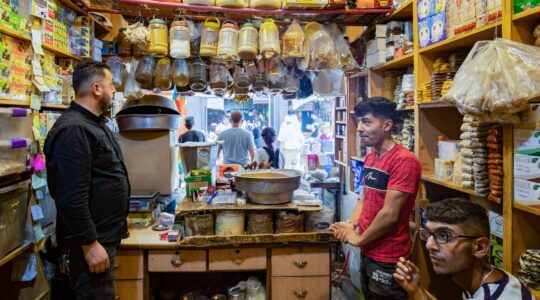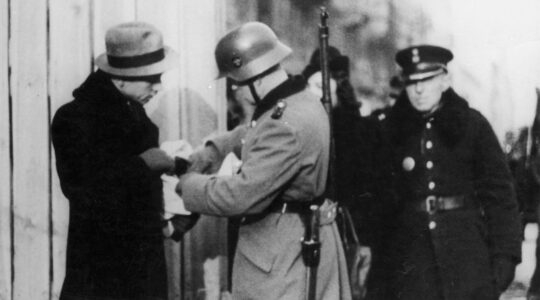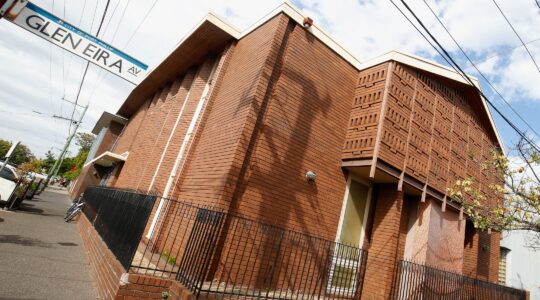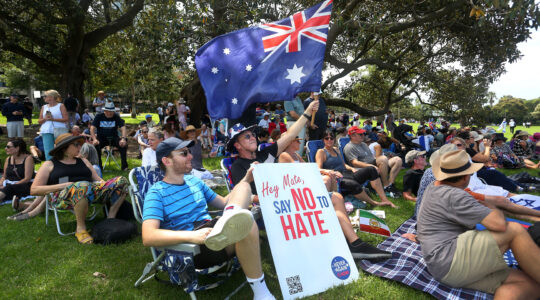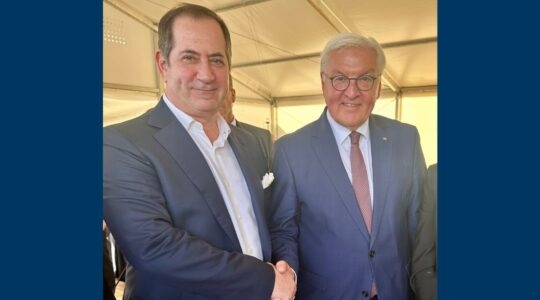DOKSHITSY, Belarus (JTA) – A smattering of the 7,500 residents of this village where Jews once lived huddle under their umbrellas as the rain falls.
They peer over their shoulders to catch a glimpse of Aaron Ginsburg, who traces his ancestors here, reciting a speech through tears.
“Dokshitsers made new lives in the United States, Canada, South Africa, Australia and what would become Israel,” Ginsburg tells the crowd as a camera from Belarusian state television focuses on him. “Few came back. Those who did found all they had loved gone. We are their children and grandchildren.”
Behind Ginsburg stand 170 gravestones etched with faded Hebrew inscriptions, the most recent reincarnation in a patchwork effort by local authorities, local Jewish communities and returning descendants to restore Jewish cemeteries across Belarus.
Ginsburg, a pharmacist and amateur genealogist from Sharon, Mass.,played a vital role in the Dokshitsy project that is being marked on this May day.
Few, if any, Jews remain in Dokshitsy. Some 2,800 were rounded up and shot during World War II in a field across from where the cemetery stands. More than 800,000 Jews were slaughtered in Belarus during the Holocaust.
Now the Belarusian government – often referred to as the last dictatorship in Europe – appears to be taking a new direction to honor the victims.
The country maintains “troubling” ties with Iran that bear little benefit in economic or political spheres, says Jonathan Moore, who currently heads the U.S. Embassy in Minsk after the ambassador was forced to leave the country earlier this year in a diplomatic tit-for-tat.
Last October, President Alexander Lukashenko made anti-Semitic comments during a radio broadcast. But a month later, Lukashenko met with Lev Leviev, the diamond magnate and ardent financial supporter of the Chabad-Lubavitch movement in the former Soviet Union.
Since the sit-down, local officials – with Jewish community leaders – have taken some initiative in restoring several Jewish cemeteries that were threatened by construction, including Dokshitsy, according to American Jews interested in reconstructing hundreds of cemeteries across Belarus.
In Gomel, a city of 500,000 in southern Belarus, construction workers stumbled across hundreds of Jewish remains during a stadium expansion earlier this year. Moore said city officials consulted with Jewish leaders and recruited local Jewish students to relocate the remains in a “sign of wanting to do the right thing.”
“The bar of expectations of the local community is low,” Moore said.
Olga Baskina, a physician and member of Hillel Minsk, says the youth group has started making summer trips to clean up cemeteries. They have cleaned up eight in recent years, she said.
Ginsburg has spent the better part of a decade tracing his family back to Dokshitsy, a two-hour drive north of the capital Minsk.
Touring the village, it is easy to imagine rows of shtetl houses lining muddy roads in the early 20th century before the Nazis purged the town. Ginsburg says many of the Jews already had left by then for the United States or what would later become Israel. Hundreds of others met their tragic fate in the field.
The monument on the spot where the 2,800 were murdered memorializes the “victims of fascism” but does not mention the Jewish background of the victims.
The Jewish cemetery was demolished in 1965, a time of religious repression across the Soviet Union. Tombstones were removed or buried, and the park lay fallow for 40 years.
Upon unearthing the gravestones, town officials decided to preserve the cemetery and sought someone to help. In February 2006, Ginsburg received a letter from city officials saying the town wanted to right a wrong against the Jewish citizens of Dokshitsy.
Ginsburg created the non-profit Friends of Jewish Dokshitsy and raised more than $28,000 to help fund the cemetery’s reconstruction.
What had been a field of gravestones buried or strewn about is now a fenced-off area with more than 100 gravestones standing upright and a marble monument with inscriptions in Hebrew and Belarusian.
A smooth stone pathway leads from the road to the cemetery gate. All of it was built by the Dokshitsy city government.
For the trip, Ginsburg united 14 people with ancestors from Dokshitsy and brought them to the cemetery, where they recited the Mourners’ Kaddish. The descendants came from South Africa, Israel, Russia and the United States.
The grandfather of Mark Izeman, an American lawyer who is currently based in Moscow for the Natural Resources Defense Council, was born in the Belarusian village.
As Izeman spoke to local residents in a City Hall ceremony and at a school assembly, he showed a portrait of his grandfather as his hand rested on the head of his young son.
“I wondered why they did all this,” Izeman told JTA. “Is it guilt? But after being here, I think they are happy to help close the circle.”
Town officials at receptions and official introductions for the 14 visitors tied the plight of Dokshitsy’s Jews to a staple of Belarusian national pride – the remembrance of World War II.
“The fate of the Belarusian people and of the Jewish people are one,” said Oleg Pinchuk, the chairman of the Dokshitsy region. “We have gone through similar tragedies.”
That spirit of shared struggle is a far cry from when Michael Lozman of Albany, N.Y., led his first group of American college students to Belarus for a cemetery restoration project in 2002. The group was detained by the KGB and questioned about their activities before being released.
Last week, Lozman led his latest group of 20 students and professors from Siena College in Albany, N.Y., to a picturesque hillside on the outskirts of Rubyazhevich, a village about 45 minutes southwest of Minsk.
The group from the Franciscan Catholic school unearthed some 300 gravestones and cut through more than 50 years of overgrowth.
Lozman, an orthodontist with fingers rough and worn from seven years of reviving cemeteries across Belarus, shook his head as he looked across the stones, each of which had been marred by a number scrawled in white paint by an earlier cemetery restoration effort.
“There’s a difference between doing it and doing it well,” he told JTA.
For eight hours, the Siena group and local children hacked away at the overgrowth and tugged at gravestones weighing hundreds of pounds.
They transformed one cemetery; over the hill were another 100 stones to dig up.
“Every time I complete a cemetery, I take some joy,” Lozman said. “But mostly I think about the fact that there are hundreds more out their waiting.”
JTA has documented Jewish history in real-time for over a century. Keep our journalism strong by joining us in supporting independent, award-winning reporting.
